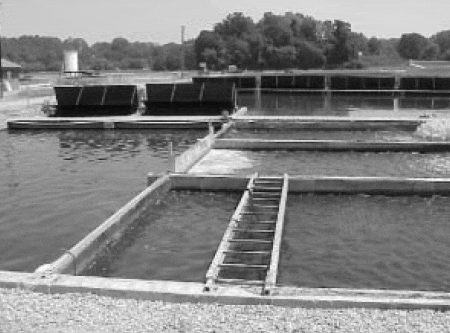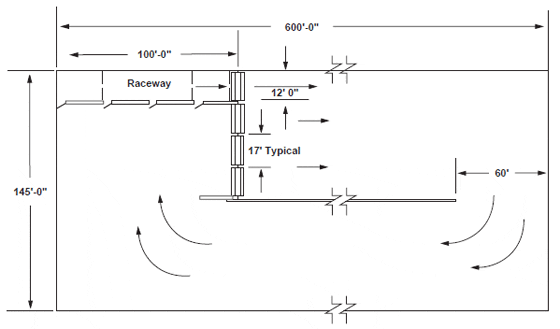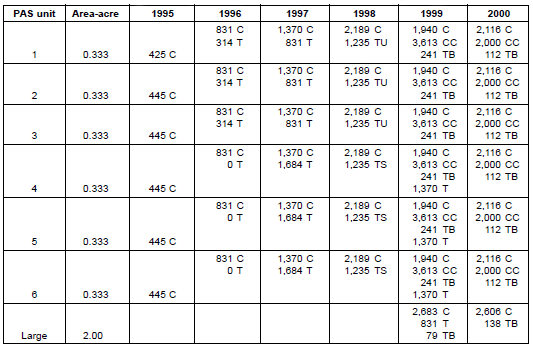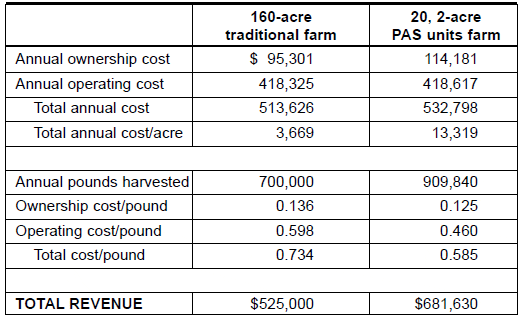Most aquaculture production comes from land-intensive systems such as catfish farms. These systems produce an average of 4,000 to 5,000 pounds per year with feed rates that average 35 pounds per acre per day. The major advantages of pond fish culture are the low capital cost of earthen ponds and the reliability of pond fish production. Disadvantages are the need to continuously manage pond oxygen concentration and other fluctuating water quality variables, prevent off-flavor, control predators and disease, and provide labor for harvesting. These management difficulties, combined with land, water and environmental constraints, have driven the search for technological improvements in pond aquaculture.
One solution has been to shift to more energy-intensive systems, either by increasing aeration (1 to 20 hp per acre) in low-cost ponds or by abandoning ponds altogether in favor of recirculating tank or raceway processes.
In Southern climates, 1,000 to 1,500 pounds of fish per acre can be produced in unaerated, “still water” ponds. Adding paddlewheels and aerators has allowed farmers to push pond annual production to sustained levels of 4,000 to 5,000 pounds per acre. The external aeration is necessary to overcome low dissolved oxygen concentrations caused by the diurnal oxygen cycles of algal production in the pond. Typically, algal production varies from 1 to 6 g of inorganic carbon (C) fixed per day per square meter of water surface area. The average, 3 g C/m2 per day of algal fixation, corresponds to approximately 0.50 mg/l per day of algal nitrogen uptake (in a 1-m-deep pond), which amounts to a pond assimilation rate of 80 to 150 pounds of feed per day, the conventional aerated pond limit. If feed rates are higher than this, ammonia nitrogen usually must be removed from the pond.
Partitioned Aquaculture Systems
The Partitioned Aquaculture System (PAS) developed at Clemson University combines the process control advantage of recirculating aquaculture with the lower cost of pond aquaculture. Many of the management problems of conventional pond culture are linked to the daily diurnal cycles of oxygen production and the longer term waxing and waning of uncontrolled algal photosynthesis in ponds. The continuous nutrient enrichment of a pond drives photosynthesis; however, unmanaged algal populations in conventional ponds typically yield only 2 to 3 g C fixation/m2 per day. Algal carbon fixation rates can be increased with lowenergy paddlewheel mixing of the bulk pond water. This technique (often referred to as a “high rate algal pond”) can sustain algal yields of 10 to 12 g C/m2 per day. With this increase in algal photosynthesis comes a similar increase in the rate of pond water detoxification (ammonia removal) and a solar-driven oxygen production system. The PAS superimposes a water velocity field upon the pond, making it possible to reconfigure the pond into separate, controllable compartments for the processes of fish culture, gas exchange, algal growth and waste treatment. A high rate of photosynthesis makes possible a solarpowered biological waste treatment capacity that is sustainable (unlike fossil fuel systems). The PAS adapts algal production to produce a sustainable, lowimpact, high-yield, and more controllable fish production process.
Beginning in 1989, scientists at Clemson University attempted to develop a system that offered the advantages of high-density raceway culture while coupling waste treatment to the kind of high-rate algal systems previously developed for treating domestic wastewater. Central to the economic success of the PAS is an energyefficient means of moving large volumes of water at low velocities uniformly throughout the pond. Uniform water velocities can best be achieved with the use of low rpm (1- to 3-rpm) paddlewheels. This technique of coupling algal growth basins (or high-rate algal ponds) and high-density fish raceways with a paddlewheel-driven water velocity field was termed the Partitioned Aquaculture System (PAS). The PAS partitions pond fish culture into a series of physical, chemical and biological processes linked by computer-controlled, uniform water velocity.
The PAS as operated in 1995 (in 1/3-acre prototypes) is represented schematically in Figure 1. The low-speed paddlewheel moves water through the algal basin and fish raceways so the operator can control oxygen and carbon dioxide concentrations in the water. The uniform water velocity field 1) mixes and disperses nutrients into the entire water column, 2) rapidly turns over algal biomass into the photic (light) zone to ensure maximum algae production, and 3) controls water quality across the raceway. A solidssettling basin at the discharge (end) of the fish raceway is where solid waste and/or flocculated algal solids are removed. A relatively shallow (1.5-foot) algal culture basin enhances the rate of photosynthesis, thus increasing fish annual production to 10,000 to 25,000 pounds per acre. The algal culture basin is the waste treatment site. The PAS technique (at the highest yields) depends on the co-culture of filter-feeding fish, shellfish or detritivoirs. As these species continuously harvest algae they control the age of algae, the total standing crop of algae, the rate of algal respiration, and the rate of oxygen production. Coproducing filter feeders makes nutrient removal environmentally friendly and sustainable, while yielding a secondary fish crop.

PAS Design and Operation
The PAS design has evolved over 15 years. During the early years (1989-1993) research focused on optimizing algal culture basin depth, mixing speed, gas exchange and high-density (cage) culture of catfish using four 1/36-acre PAS units. In 1995, six 1/3-acre PAS units were installed. From 1995 to 2001, the limit of the fish carrying capacity was examined and the use of tilapia coculture explored. Finally, in 1999, a single 2-acre commercial scale prototype was installed (Figs. 2 and 3).

System Paddlewheels
The PAS units use low-speed (1- to 3-rpm) paddlewheels driven by oil hydraulics to move large volumes of water at relatively low head (0.5 to 2.0 inches ?H). The power needed to drive the paddlewheels can be calculated using equations for fluid mechanics describing flow in open channels (see SRAC Publication 374). In the final design, the power requirement of the motor should be based on the “worst case” expected power (highest velocity) and increased to adjust for mechanical losses. Because of the desire for a wide range of water velocities and the use of a single power unit to power two sets of paddles, the 2-acre PAS prototype was fitted with a 3-hp motor, well in excess of actual required power.

One of the important modifications of the 2-acre PAS prototype was the use of a second paddlewheel system to independently control raceway water quality (i.e., independent from the algal reactor). This arrangement allows for more precise computer control of dissolved oxygen, ammonia and carbon dioxide concentrations in the fish raceway. Cost was reduced by eliminating the multiple channels in the algal culture basin originally used in the 1/3-acre and 1/36-acre PAS units (compare Fig. 1 to Fig. 2). The 2-acre system uses a gang of pad dlewheels with a single 70-footwide by 600-foot-long algal growth channel.
Fish Raceways
The 2-acre system uses a threechannel raceway with the central channel serving to distribute water into the fish raceway (overview seen in Fig. 2). The flow distribution to the raceway is “distributed plug flow,” where individual fish sections are maintained at uniform water quality by introducing side flow velocities in direct proportion to the oxygen demand of each section. Water velocity across the fish raceway is provided by a separate paddlewheel. In this way, the flow and water quality in the fish raceways can be controlled independently of the algal basin. High densities in each fish raceway result in uniformly mixed raceway conditions. In 1999, stocking density experiments showed that 8 to 10 lbs./ft3 of catfish could be sustained with no adverse effect on growth, suggesting that overall system costs can be further reduced by using a single high-density raceway and fewer paddlewheels (Fig. 4).
Other advantages of high-density raceway culture are that inexpensive netting can be stretched across the top of the raceway sections to keep out predators, and fish confinement allows for more efficient use of chemicals to treat or prevent fish diseases. The walls of the prototype were constructed of concrete- filled cinder block, although formed concrete or wooden raceways have been used with similar success.
Algal Basin Flow Patterns
To reduce construction cost, the algal culture basin channels were reduced from six in the 1/3-acre units to two in the 2-acre units. This reduced the partition/wall requirement from 3,000 feet per acre to 600 feet per acre. The central dividing wall was constructed of 4- foot-wide, 0.032-inch, black polyethylene attached to a conventional 6-inch mesh “hog wire” fence buried 1 foot in the soil and supported by steel posts. This forms a plastic curtain wall 3 feet high.
Flow experiments were conducted in 1999 in the 2-acre unit to determine the uniformity of the water velocity field that can be sustained with different combinations of paddles and paddle rpm. The results suggest that sufficient mixing and flow velocity in the algal channel can be maintained with 50 percent of the flow path driven by paddlewheels in the algal channel.
Primary Production in the PAS
The most important difference between conventional pond aquaculture and the PAS is the increased algal growth achieved in the homogenous water velocity field. This 3- to 4-fold increase in photosynthesis is the basis for the 3- to 4-fold increase in fish carrying capacity.

Algal Biosynthesis
The algal biosynthesis that removes carbon dioxide and ammonia from the pond and adds oxygen to it is the key to the continuous waste treatment, and reuse of pond water, in the PAS. The amount of carbon dioxide and ammonia removed and the amount of oxygen added per unit of algal biomass produced can be predicted from the equation representing algal biosynthesis;
106 CO2 + 16 NH4 +52 H2O + PO-3 =
C106 H152 O53 N16 P + 106 02 + 16 H+
The increased rate of algal biosynthesis and the harvest of algae by filter-feeding fish is the basis of the improved performance of the PAS over conventional pond culture. Six years of catfish production trials with the PAS confirm that maximum algae production can reach 10 to 12 g C/m2 per day, similar to that reported in other paddlewheel-mixed, highrate algal culture systems. At this rate of waste treatment, feed assimilation rates of 200 to 250 pounds per acre per day and fish production of 10,000 to 20,000 pounds per acre have been confirmed (see Table 1). Because of the high water treatment capacity of the PAS, water does not have to be discharged to the environment.
Algal Management with Tilapia Co-culture
The PAS uses co-culture as opposed to polyculture. In polyculture, different species of fish are stocked into the pond and allowed to feed at large. In PAS culture, the target species (catfish) are physically separated from the filter-feeding fish. In the PAS growth trials, Nile tilapia (Oreochromis niloticus) were the cocultured species. These fish were selected because of previous proreports of their ability to feed on algae.
The impact of the tilapia on algal production in the PAS was quantified over a period of 6 years. Coculturing with tilapia reduced the age of algae from 6 to 8 days to 4 to 6 days and the algal standing crop from 100 to 150 mg/l to 50 mg/l. By 1997, a successful tilapia stocking ratio of 25 percent of catfish biomass at the end of the season stabilized algal biomass at approximately 50 mg/l (dry weight) and algal cell ages at 2 to 4 days, in spite of a catfish carrying capacity 60 percent greater (8,818 pounds per acre) than in 1996. The important link between young algal cell age, stable algal populations and improved water quality was clearly established. In general, if the PAS is operated with sufficient tilapia biomass (>25 percent of catfish biomass at the end of the season), algal densities range from 40 to 60 mg/l, producing Secchi disk readings of 15 to 18 cm. If tilapia populations are not maintained and if catfish are stocked at more than 10,000 lbs./acre, algal densities are usually 100 to 150 mg/l dry weight, producing Secchi disk readings of 5 to 10 cm2. This leads to excessive dissolved oxygen cycling and low night-time DO levels.
Another advantage of tilapia coculture is that it reduces the dominance of cyanobacteria. Beginning in 1998, the PAS units were stocked only with tilapia “breeding pairs” (100 per acre). As tilapia grew in number and weight during the season, the early dominance of cyanobacteria shifted to phytoplankton populations of more desirable green algae. Supressing cyanobacteria reduces off-flavor. By 1999, the 2- acre unit was dominated by green algae and off-flavor ranged from 1.0 to 1.5 (out of 5) at the time of harvest. This mild off-flavor was described as being “grassy.”
PAS Fish Management and Stocking
From 1995 to 2000, the six 1/3-acre PAS units were stocked with catfish fingerlings (size classes of 18, 30 and 60 g) ranging from 396 kg/ha (1995) to 1,950 kg/ha (1998) (Table 2). The carryover of undersized catfish was initiated in 1999. In 1999 and 2000, 3,218 kg/ha and 2,000 kg/ha of catfish, respectively, were carried over. Tilapia fingerling co-stocking ranged from 280 kg/ha in 1996 to 1,500 kg/ha in 1999. Stocking sexed vs. unsexed tilapia was investigated in 1998; no advantage was observed. The stocking of 100 to 215 kg/ha of adult tilapia breeding pairs began in 1999. The breeding pair stocking was ultimately adopted as the lowest cost and least labor intensive way to supply sufficient tilapia at the end of the season to control both algal density and dominant species. While this stocking technique does not control algae year-round, it is an acceptable compromise, given the increased cost of producing tilapia fingerlings indoors (heated) for spring stocking.
Performance of the 1/3-acre PAS from 1995 to 2000.

PAS Catfish and Tilapia Stocking Rates (Pounds/acre) for the 1995 to 2000 Growing Seasons.1

Fish Production and Feed Application Rate
Net catfish production in the six 1/3-acre units increased from an average of 3,078 pounds per acre (3,456 kg/ha) in 1995 to 17,263 pounds per acre (19,382 kg/ha) in 2000 (Table 1). By 1997, maximum daily feeding rate reached 200 pounds per acre (224 kg/ha), with an average daily feeding rate for the season of 94 pounds per acre (106 kg/ha).
Maximum fish carrying capacity reached 17,001 pounds per acre (19,087 kg/ha) in 1999. In 2000, net catfish production exceeded maximum carrying capacities because of the end-of-year catfish carryover with both early- and late-season fish harvest. Deaths of carryover fish from proliferative gill disease, and lower feed quality, limited 1999 production to 14,888 pounds per acre (16,715 kg/ha) average.
The PAS carrying capacity and yield were incrementally increased over the 6-year period so that researchers could evaluate tilapia co-culture for algal management, water quality control, and increased catfish density. Tilapia co-culture was found to improve water quality and reduce aeration requirements, so it was adopted as standard practice. By 2000, net catfish production averaged 17,263 pounds per acre (19,382 kg/ha) with only 100 kg/acre of tilapia breeding pairs stocked in early spring.
Fish Health Management
When fish are confined in raceways, chemical treatment of diseases is easier, less expensive and more effective than when fish are in ponds. Controlling the oxygenation of the water also is more effective and less costly than in ponds. Early in the PAS trials (before tilapia co-culture), it was necessary to treat the whole pond for toxic cyanobacteria. When fish in the fish raceway flow are isolated from the algal culture basin such treatments can be made if needed.
Columnaris was the most significant disease problem in the PAS. It was controlled effectively with medicated feed and, because of system design, with potassium permanganate. Periodic Costia and monogenetic trematodes were controlled with 1-hour exposure to 250 ppm formalin in the fish raceways. Infrequent occurrences of brown blood were treated by adding sodium chloride to the entire system. Proliferative gill disease (PGD) has affected the winter carryover fish in the PAS. Mortalities ranging from 25 to 100 percent of overwintered fish have limited production to 17,000 pounds per acre, as opposed to the 20,000 to 23,000 pounds per acre expected from successful grow out of carryover stock. Lowering the pH of sediment by applying hydrated lime has reduced the incidence of PGD in carryover fish in the early spring months.
System Economics
An economic analysis of the PAS (Table 3) compares 40 acres and 180 acres of PAS units (with a maximum net projected production of 909,800 and 3,775,670 pounds of catfish) to traditional 160-acre catfish farms (producing a net 700,000 and 2,845,000 pounds of catfish). The analysis suggests that the PAS could reduce production cost by as much as 13 to 19 cents per pound. This analysis is dependent upon successful grow out and carryover of the undersized, overwintered fish (approximately 20 percent of the total harvest). To date, PGD has prevented that. Unless corrected, the losses from PGD would make PAS production costs 2 to 5 cents per pound higher than traditional production.
Summary
Aquaculture is growing at about 20 percent per year and will, within the next two decades, produce more than natural fisheries. The future development of aquaculture will be severely constrained by the availability of water and environmental concerns. The PAS has the potential to significantly increase fish production per unit area over conventional aquaculture techniques while reducing water requirements by 90 percent per pound of fish produced. This makes it possible to install PAS facilities at sites not suitable for conventional aquaculture production.
Comparison of Estimated Annual Ownership Costs, Operating Costs, and Unit Costs.




